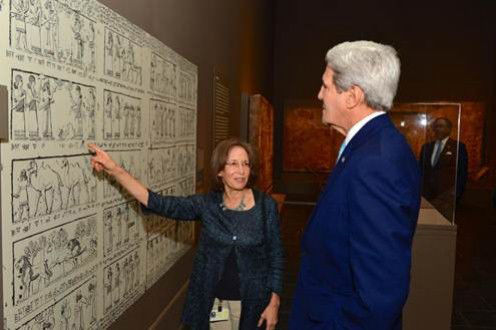
Secretary of State John Kerry viewing the exhibition with Joan Aruz, Curator in Charge of the Department of Ancient Near Eastern Art
Joan Aruz
The visitor to the Assyria to Iberia exhibition takes many journeys: one across the centuries that bridge the collapse of Bronze Age palatial societies and the rise of the decentralized world of the Iron Age; one that emerges from the Assyrian heartland—the palaces of Nimrud and Nineveh—with the campaigns of the Assyrian army that brought much of western Asia under its yoke, spreading artistic styles in the wake of war and initiating a flow of treasures into the capital; and, finally, the extraordinary journey of Phoenician sailors, extending across the Mediterranean, through the Greek islands, Etruria, Sardinia, Carthage, and Iberia, initiating an era of unprecedented cultural encounters. As curator of this exhibition, this was also a voyage of discovery, one in which each local museum I visited was replete with material evidence of such encounters, stimulating while challenging me to find a way to convey the complex interactions at the "dawn of the classical age" as manifested in the magnificent artistic record of this era. It is a time little known to the general public but one that demands our attention for the understanding of the course of civilization and the relevance of this first "global" age of communication to our own world. A superb team of designers and installers worked tirelessly to realize my vision of an exhibition that would evoke a sense of place—carrying us across the lands of the east and then across the sea to the farthest reaches of the Mediterranean.
During the course of the exhibition, a number of notable visitors shared this journey with me and often during these tours others would stop me to share their appreciation of the show and tell me how its meaning has been magnified by the news of current threats to the regions that have revealed their rich artistic heritage in the exhibition. After nearly five years of planning, it will be sad to see the works of art that have so enriched our experience of the past by being placed together for the first time soon be packed up and sent back into isolation in their home institutions. Yet, the memories of these last few months, in which not only these works but also so many members of the museum staff came together to create this show, will linger. Among the many people who worked on the exhibition, I must point to four outstanding individuals in the Department of Ancient Near Eastern Art, who have joined with me to share their own thoughts about this extraordinary experience that we were all privileged to share.
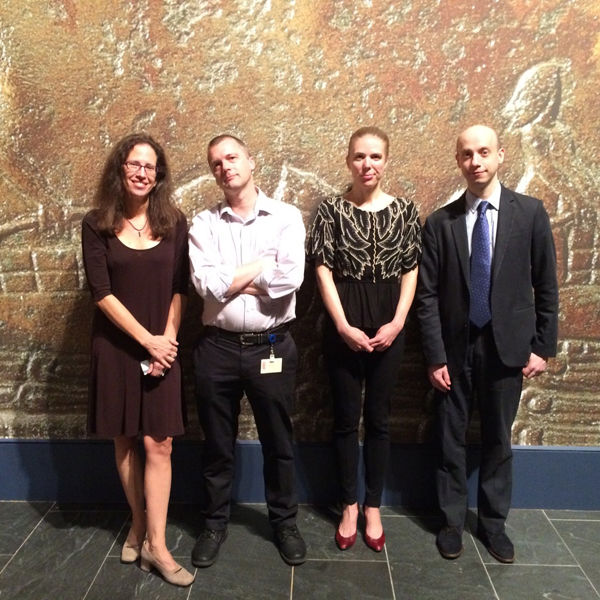
Left to right: Yelena Rakic, Associate Curator; Tim Healing, Senior Administrator; Sarah Graff, Assistant Curator; and Michael Seymour, Assistant Curator, all of the Department of Ancient Near Eastern Art
Michael Seymour
Since the opening of Assyria to Iberia, friends, colleagues and visitors have been asking me which is my favorite object in the show. At first I did my best to dodge the question, both in an effort to be diplomatic and because I genuinely didn't know. Also perhaps a little embarrassment: in some ways it doesn't seem a very grown-up way to think about the material! But people kept asking, and it slowly dawned on me that I was wrong: that it can be a very interesting question, forcing scholarly interests to run up against more personal reactions and the many modern prejudices one inevitably brings to the viewing of ancient art. I think that I am now ready, very un-diplomatically, to choose. My personal favorite object in the show is the seventh-century B.C. Assyrian relief group known as the Battle of Til-Tuba (see image below). It might seem an odd choice: it's a monumental depiction of extremely violent events, and the exhibition is filled with works that are much more intimate, often with religious iconography that, given a little consideration of its ancient context, can move the viewer and teach us something about the tremendous power of imagery in the ancient world. The Til-Tuba reliefs, by contrast, document the triumphant Assyrian army pursuing the remnant of their defeated Elamite enemies, and capturing and executing their king, Teumman. So, why Til-Tuba? I have now seen this extraordinary relief cycle daily for the past four months, often looking in some detail with groups of visitors or on my own, and, simply put, the more one looks, the more there is to see. The complexity, rhythm, and balance of the innovative, swirling composition is a brilliant technical feat, because the many vignettes it contains each appear both as powerful and immediate scenes in themselves, rich in interesting and revealing details, and as coherent contributions to the overwhelming impression given by the whole. That impression is one first of the chaos and tumult of war and then, as one gets closer and focuses in, of the many small, individual acts of violence of which war consists. The Til-Tuba reliefs offer a powerful journey from a somewhat distant and abstracted perspective to the specific, vivid, often disturbing experiences of individual combatants. They are also packed with information, the sheer depth of which only gradually becomes clear on repeated viewing. In their ancient context the reliefs were produced as a triumphal monument; today, most viewers see in them the horrors of war. In either case, it is helpful to keep in mind that it was not the violence that was unique to ancient Assyria, but the strangely meticulous and unflinching way in which it was documented.
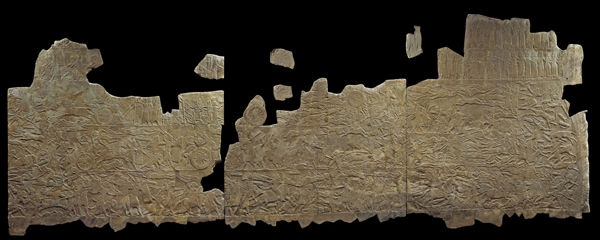
Limestone reliefs depicting the battle of Til-Tuba. Neo-Assyrian, ca. 660–650 B.C. Nineveh, Southwest Palace, Room XXXIII. The Trustees of the British Museum, London (BM ME 124801 a–c)
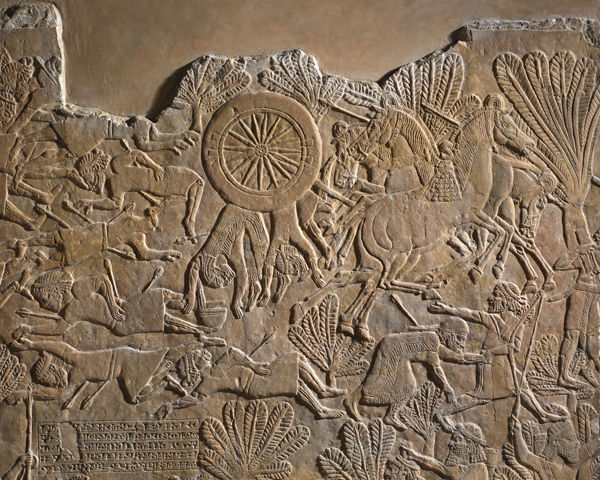
Limestone reliefs depicting the battle of Til-Tuba (detail). At top, the Elamite king Teumman and his son Tammaritu are thrown from their cart. At bottom right, Tammaritu attempts to lead the wounded Teumman to safety. Subsequent scenes show Tammaritu making a last stand as he attempts to defend his father with bow and arrow, before the two are captured and killed by Assyrian soldiers
Sarah Graff
Being an art historian of the ancient Near East can sometimes be rather abstract work: studying objects in different museums and from different sites all over the world requires us to rely on photos and drawings as reminders of works of art seen years ago while traveling, or works of art we have never actually shared space with, but only seen secondhand. So when we have the chance to see a favorite object in person, it is a very special thing. This is true for me, whether the piece is in the permanent collections of the Metropolitan Museum, or whether it is located in a distant country, or has traveled thousands of miles in order to be installed in a special exhibition. The charisma that a work of art radiates cannot be denied. It is something I experience when the work and I share the same space, and I bring my own perspective to meet that of the object itself. This is why I am still seeing new details in the reliefs from the Northwest Palace of Ashurnasirpal in our Assyrian relief gallery, even after living with them for years. And it is why the arrival of objects for the Assyria to Iberia exhibition was a moment for giddy excitement, as the crates were dismantled and the pieces emerged from packing materials to dazzle us with their undeniable presence. Some, like the Salamis cauldron, brought a sense of high drama through their imposing scale; others, like the glowing golden garments of the gods from Delphi, awed me with their fine detail, made by sure and confident hands thousands of years ago. A special pair was the cauldron with six inward-facing lion protomes from the Regolini-Galassi tomb in Etruria, belonging to the Vatican, and the lion protome from Karmir Blur in Urartu, belonging to the History Museum of Armenia. The two have frequently been compared, and many scholars have agreed that they are closely related, but they have never been displayed together before this exhibition. Now that we are lucky enough to see them both at the same time, their many differences are actually what stands out about the juxtaposition! I love that we have been able to take this straightforward comparison and view it from another angle. It is a vivid reminder to me that reclaiming a direct relationship with the objects themselves will always surprise, instruct, humble, and delight.
![Bronze cauldron and iron stand. Cypro-Archaic, ca. 8th–7th century B.C. Cyprus, Salamis, Tomb 79. Cyprus Museum, Nicosia (SAL T.79/202, 202[b])](/-/media/images/exhibitions/2014/assyria-to-iberia/blog/reflections5.jpg?sc_lang=en&hash=5C972C139C53594ED47BC070F839F2B8)
Bronze cauldron and iron stand. Cypro-Archaic, ca. 8th–7th century B.C. Cyprus, Salamis, Tomb 79. Cyprus Museum, Nicosia (SAL T.79/202, 202[b])
Yelena Rakic
As I have spent time in Assyria to Iberia I have become increasingly interested in how objects intersect with our views of history and how this plays out in a museum setting. I was particularly struck with the notion that if we could travel back in time—a little more than 150 years—to say around 1840, almost none of the objects brought together in this exhibition would be here. They had not yet been discovered/uncovered. [The exceptions are the Nora Stele (1773) and objects from the Regolini-Galassi Tomb (1836).] We would however still have known about many of the exhibition's main "players"—the Assyrians, the Phoenicians, the Philistines. We could tell a story but it would be a different one; one that relied on the Bible and classical authors such as Homer as our sources. In fact, our view of the world presented in Assyria to Iberia is still heavily influenced by these biblical and classical traditions and they are introduced in the first gallery and run like a thread through the exhibition. But by bringing in the objects we add another dimension to our narrative and one that highlights the role of archaeology in shaping our understanding of this Iron Age world, and, as often is the case, new discoveries can challenge our narrative and force us to reconsider it. We need to always keep in mind that objects have multiple lives—their ancient lives tell us about the past but they also have modern lives that reflect their existence after they were recovered/discovered. And sometimes their modern lives are just as fascinating as their ancient lives.
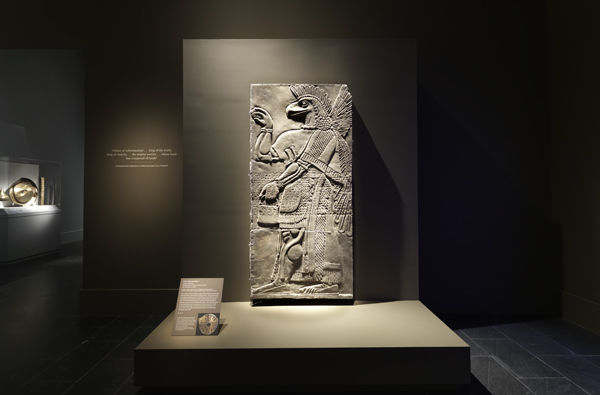
Gallery view showing the relief with winged figure, Nimrud, Northwest Palace of Ashurnasirpal II, Williams College Museum of Art, Williamstown, Massachusetts; Gift of Sir Austen Henry Layard through Dwight W. Marsh, Class of 1842 (WCMA 1851.2)
This relief on loan from the Williams College Museum of Art is one of the two first Assyrian reliefs to arrive in the United States in 1851, soon after the great Assyrian capitals had begun to be uncovered in the 1840s by European explorers. These reliefs and others arriving soon after were sent to colleges in the northeastern United States by missionaries stationed in Mosul, in order to prove the truth of the Bible and perhaps inspire students to serve God. While these discoveries did show in a general sense that Assyria had existed as known from the Bible, today the reliefs are appreciated for other reasons as well. We now consider their aesthetic properties, their historical context, and many other aspects beyond their biblical connections, revealing them as monuments with multifaceted interpretations.
Tim Healing
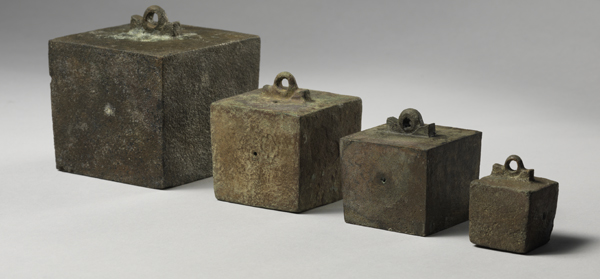
Four cuboid pan-balance weights (BC11-3183, BC11-3246, BC11-3202, BC11-3270). Museo Nacional de Arqueología Subacuática, Cartagena.
What I'll take away most from Assyria to Iberia is not just the beauty of the art or the fantastic design of the show, but the fact that the exhibition itself is essentially about people; everyday, working, living, breathing people. A majority of the art was excavated from tombs or royal sites that highlight how the wealthy and elite lived, but for me the most personal and therefore the most memorable items are those that indirectly give an insight, and tell the story of the ordinary people who happened to live their lives in the first millennium B.C. These are the artisans and craftsmen who carved the raw ivory into furniture fittings or tridacna shell into cosmetic containers; the sailors who transported their goods across the Mediterranean ultimately to give their lives on the Bajo de la Campana shipwreck; the scribes who etched the cuneiform writing on the Sennacherib prism, perhaps even the soldiers shown fighting the bloody battle at Til Tuba. Ultimately however, in my opinion, the most poignant symbol of daily life is nowhere better represented in the exhibition than by the set of four cuboid pan-balance weights, variants of which would have been used throughout the Mediterranean by merchants as they strived to live their lives, and that for me is the most important message Assyria to Iberia gives.
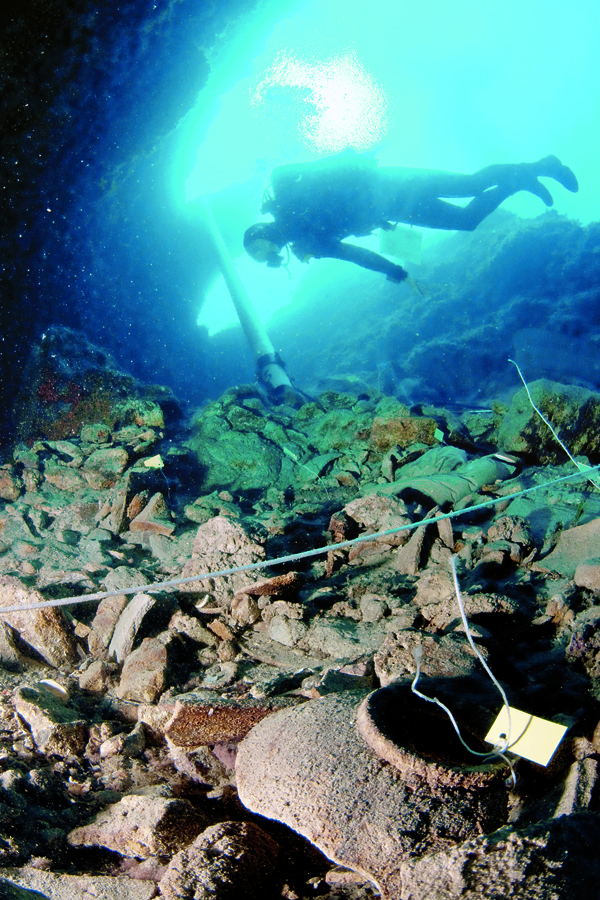
Archaeologist Neil Puckett preparing to excavate with airlift in crevice. Bajo de la Campana, 2011. © Institute of Nautical Archaeology, College Station, Texas. Photograph by Susan H. Snowden, 2011